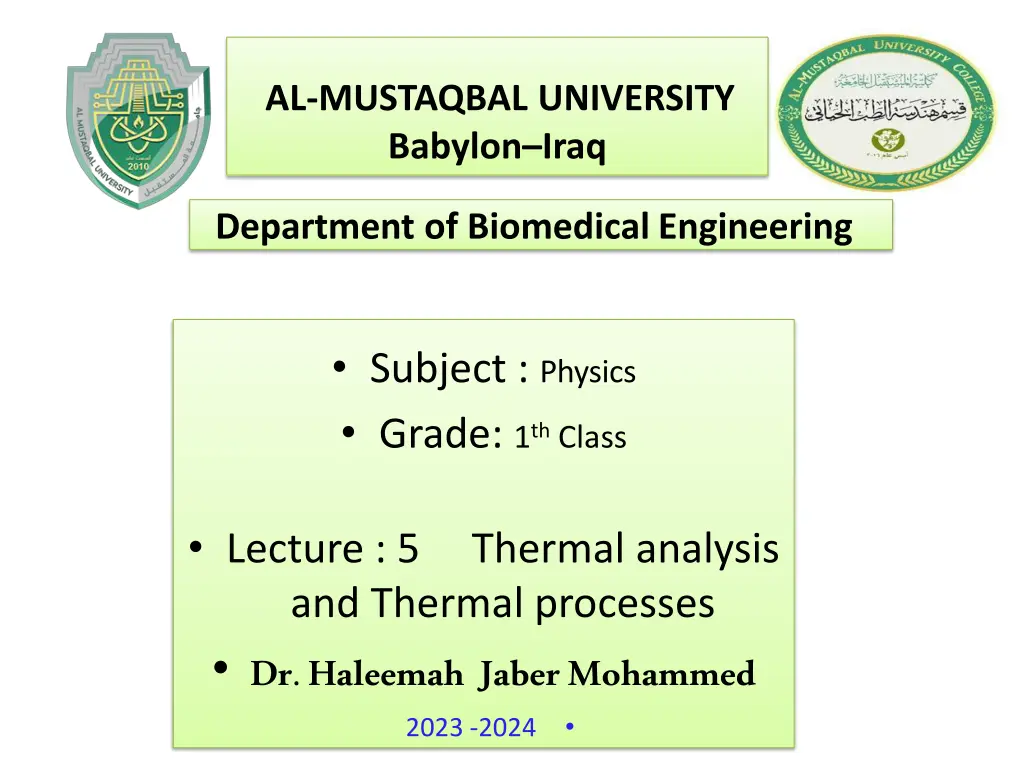
Understanding Thermal Analysis in Materials Science
Explore the significance of thermal analysis in studying material properties with temperature changes, covering both physical and chemical transformations. Learn about the methods used, the impact of temperature on materials, and the prediction of safe operating conditions for various products.
Download Presentation

Please find below an Image/Link to download the presentation.
The content on the website is provided AS IS for your information and personal use only. It may not be sold, licensed, or shared on other websites without obtaining consent from the author. If you encounter any issues during the download, it is possible that the publisher has removed the file from their server.
You are allowed to download the files provided on this website for personal or commercial use, subject to the condition that they are used lawfully. All files are the property of their respective owners.
The content on the website is provided AS IS for your information and personal use only. It may not be sold, licensed, or shared on other websites without obtaining consent from the author.
E N D
Presentation Transcript
AL-MUSTAQBAL UNIVERSITY Babylon Iraq Department of Biomedical Engineering Subject : Physics Grade: 1thClass Lecture : 5 Thermal analysis and Thermal processes Dr. Haleemah JaberMohammed 2023 -2024
Thermal analysis is a branch of materials science where the properties of materials are studied as they change with temperature OR Thermal analysis is a branch of materials science where the properties of materials are studied as they change with temperature. Several methods are commonly used these are distinguished from one another by the property which is measured
When matter is heated, it undergoes certain physical and chemical changes. 1- Physical changes include phase changes such as melting, between microstructure changes (expansion mechanical behavior. vaporization, crystal crystallization, structures, in metal alloys and polymers, volume and contraction), and changes in transitions changes in
Chemical changes include reactions to form new products, oxidation, corrosion, decomposition, dehydration, chemisorption, and the like. These physical and chemical changes take place over a wide temperature range.
Materials are used over a wide range of temperatures, from Arctic cold to tropical heat, in corrosive environments, variable humidity, and under load (stress). It is necessary to characterize materials and their behavior over a range of temperatures to determine what materials are suitable for specific uses and to determine what materials or chemicals can withstand without changing. temperature range
This sort of information is used to predict safe operating conditions for products, such as which type material is best extremely cold climates, the average expected lifetime of materials such as paints and polymers exposed to temperature changes. of tire for vehicles extremely in or hot
Types of thermal analysis TGA Thermo gravimetric analysis DTA Differential Thermal Analysis DSC Differential Scanning Calorimetry TTThermometric Titration DMA Dynamic Mechanical Analysis TMA Thermo Mechanical Analysis 4
Thermal processing thermal processes are noncatalytic processes that decompose, rearrange, hydrocarbon molecules by the application of heat. When feedstocks temperatures over 350 C (660 F), the thermal or free radical reactions start to give way to cracking of the mixture at significant rates. or combine are heated to
INTRODUTION Thermal processes are that set of processes that uses the thermal energy of a steady or a flowing fluid, to perform required work. The concepts of the thermal process are generally studied under thermodynamics and heat transfer in mechanical engineering. The subject of thermodynamics focuses on the methods to convert heat into work, or their interconversion. It also focuses on the methodology to reverse various spontaneous processes, like the flow of heat energy from a cold reservoir to a high-temperature reservoir. Thermodynamics deals with heat energy and its related energy conversion, whereas heat transfer in the context of mechanical engineering, deals with the rate of flow of heat and its various consequences
Thermal processes are the processes operate at high temperature, which is usually higher than melting point of aluminum. They are performed in the semiconductor process, temperature furnace diffusion furnace. front-end usually commonly of in the high called
Context and Applications Some of the key areas where thermal processes find their application are: Separation and purification of gaseous and liquid mixtures Cryogenic systems Water treatment Bio-refining Industrial production process Thermal processing and thermal imaging Multiphase heat transfer
Thermal used industries for processing metals and building materials, as well as for industries such as food and beverage, pharmaceuticals, chemical, biomass and numerous other applications processing technology heavy is in manufacturing
Do You Have Any Questions?






















